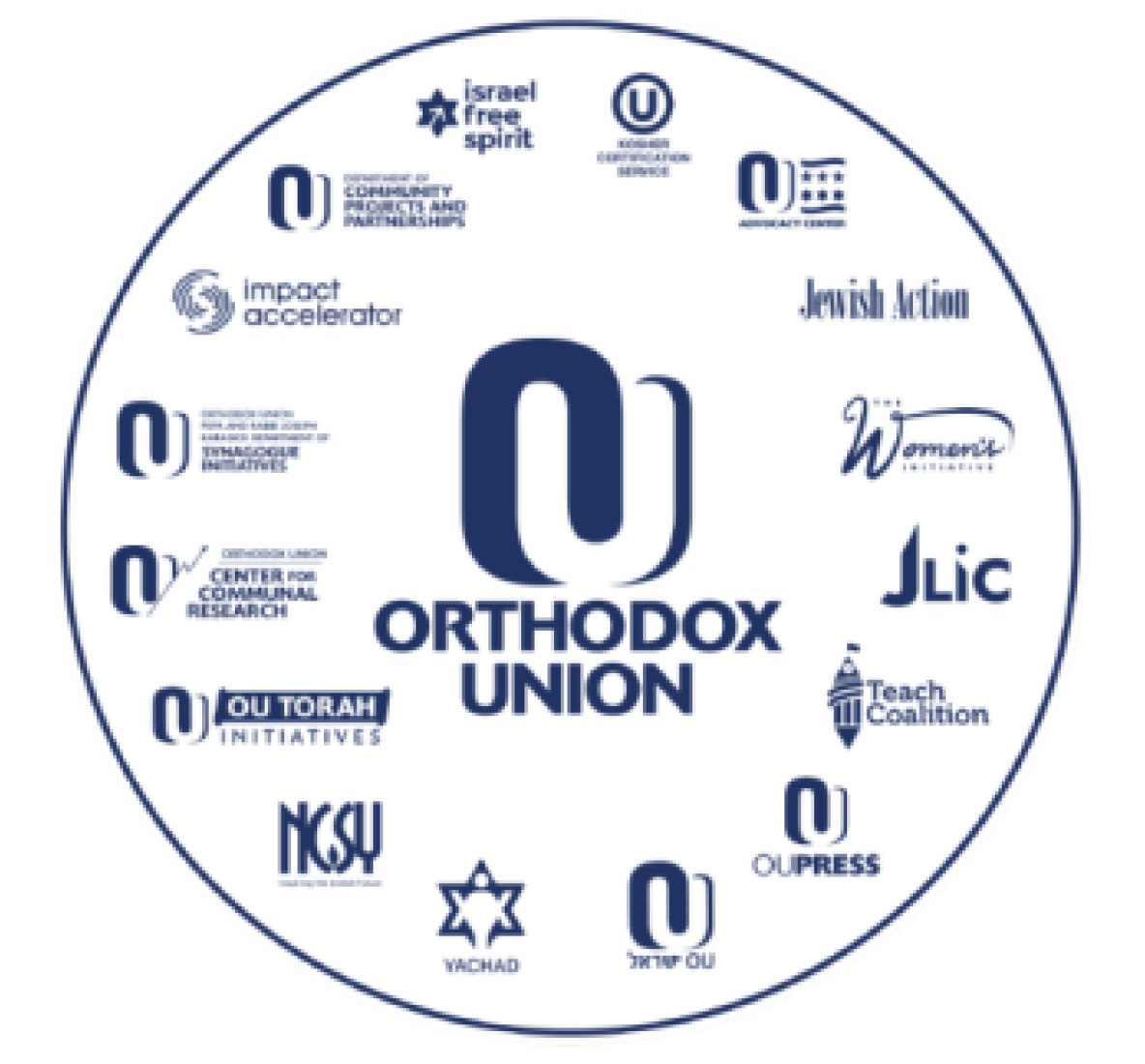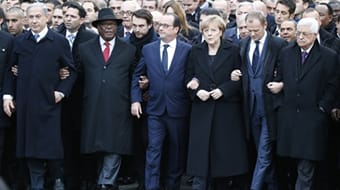There’s been a lot of buzz about the ultra-Orthodox Israeli newspaper HaMevaser photoshopping the women leaders out of a photograph of the unity march in Paris. People have had a number of reactions, largely informed by their already-existing positions on matters ranging from sexism to anti-Semitism. I’m going to share my personal reflections on these reactions with the understanding that, even if I seem contrary, I most emphatically do not agree with the altering of the photo. (We’ll come to my reasons soon enough.)
I. Altering the photo was sexist or misogynistic.
This is a common reaction. I certainly get it but I don’t necessarily agree with it. I’ll tell you why:
I travel in fairly modern circles. The OU website has pictures of women. OU Torah, which I manage, has a number of women lecturers (though I wish we had more!). The OU is actively courting female leadership because there’s a large pool of untapped talent. Despite all this, there are those who think my group is sexist and misogynistic because there are some obvious differences between men and women in ritual life.
There are some areas where we can and do (or should) accommodate. But there are other areas where our hands are tied. One of the ramifications of belonging to a religion is that it comes with the presumption that certain things are handed down from on high and are not within our power to change. In some areas, the Torah differentiates between men and women just as it does between kohanim, Leviim and Yisraelim (priests, Levites and Israelites), between first-born sons and other children, and between boys who are 13 years old and those even a day younger. People may consider me sexist or misogynistic for aligning myself religiously with a community that doesn’t count women in a minyan, but I certainly don’t feel sexist or misogynistic!
For the record, women in our community do not necessarily feel oppressed by the lifestyle or by our religious practices. My wife — a baalas teshuva, who chose to affiliate with this community — dresses modestly, covers her hair and has never had an aliyah. But she also has strong opinions and is not afraid to voice them. If anyone ever questions her choice of lifestyle as condescending to women, she laughs in their face and asks: “Do I seem oppressed to you?”
Let me take that one step further. I have a friend who lives in Saudi Arabia. (I have a number of Muslim friends and none of them want to kill you any more than you want to kill them.) A convert to Islam from Ohio, her move to Saudi Arabia was the culmination of a dream that is comparable to the way many Jews dream of moving to Israel. Of course, people questioned her conversion to Islam; for example, she chooses to wear hijab, which many think is oppressive to women but which, for her, is a religious duty. And her move to Saudi Arabia was bewildering to many people because that country is considered extremely sexist and misogynistic. While she would like to drive (forbidden to women in Saudi Arabia), and she feels the country is gradually coming around, in the big picture she is willing to overlook some flaws, because, for her, the good outweighs the bad.
So, let’s bring this back to HaMevaser. Ostensibly, the reason they don’t show women is because men shouldn’t stare at women, which objectifies them. That seems a lofty goal, though their way of accomplishing it is rather off-putting to outsiders. I’m not prepared to leap straight for the labels of sexist and misogynistic because people apply those labels to my community and I feel they are unwarranted. Things that appear sexist are not necessarily motivated by a desire to marginalize women; sometimes they are simply the product of one’s faith, which we may consider beyond our control. Just because my circle has no problem with photographs of women, I will not presume that others necessarily consider the choice to be in their hands. I will likewise not assume that women within that community necessarily feel marginalized; many of them may well agree with their community’s standard. Even those who feel that such a policy is silly or unfair may be willing to overlook this particular quirk of their community based on a feeling that the good outweighs the bad. (Basically, I cannot believe that every woman in a community that is religiously to the right of mine is only there because of Stockholm syndrome when I know that such is not the case in my own community.)
Now, I’m not naive. I’m sure that there are sexist and misogynistic men among the ultra-Orthodox. There are also such people among modern Orthodox Jews, Reform Jews, Christians, atheists, and in all other groups. I’m just not ready to automatically attribute that motivation to people I don’t know when there are less malicious explanations that are equally plausible.
II. The attention being given to this story is anti-Semitic or anti-Israel
Some people feel that the attention being given to this is driven by an agenda. Jews were killed in Paris in the aftermath of the Charlie Hebdo massacre. There was an initial attempt to whitewash this attack as not being motivated by anti-Semitism despite the statements of the shooter that he picked a kosher supermarket because that’s where the Jews would be. (This echoes the sentiment popularly attributed to bank robber Willie Sutton. When asked why he robbed banks, he reportedly replied, “Because that’s where the money is.”) Then, HaMevaser wiped the women leaders out of the photo and the international press really picked up on it.
“Aha!” some would exclaim. “They’re only making a big deal out of this to make the Jews look bad!”
So, running the story is anti-Semitic. Or it’s anti-Israel. Unless Jewish papers are doing it; then it must be anti-Orthodox. (What if Orthodox papers are doing it? Do we even have an anti-Charedi agenda? I must have missed a memo.)
The reality is, HaMevaser did something that may seem perfectly normal to them but it looks really odd to the rest of the world. They might do this 20 times per issue and it’s off the radar, but this was international news and it got noticed. Other people are naturally going to see this editing job as anything from silly to malicious. Seriously, how do you think Jews would react if another country photoshopped Benjamin Netanyahu out of a picture? Well, Angela Merkel is a world leader, too. And to omit the mayor of Paris from a Paris-based event? It’s going to ruffle some feathers.
Now, again, I’m not ruling out the possibility that some people may use this story for anti-Semitic purposes. I saw at least one article online that basically said: “Why is everybody making such a big deal out of the fact that the US didn’t send a leader to the unity march when the real story is what the Jews did?” Yeah, that’s the real story. (And, for the record, while Jews may have done it, “the Jews” didn’t.)
But just because someone runs the story, that doesn’t necessarily make their motivations suspect.
III. My problem with it
I do have an issue with the altering of the photo: it’s a news photo. Photoshopping people out of a news photo betrays a lack of journalistic integrity.
People complain when Photoshop is used to digitally enhance some actress on the cover of a gossip magazine or some model in an ad. There, the issue is often one of presenting unrealistic and unhealthy body messages. If photoshopping art for an ad is questionable, it should be a no-brainer that altering a news photo is unacceptable.
We should have learned this lesson in 2011 when Brooklyn-based newspaper Der Zeitung erased Hillary Clinton from a Situation Room photo. They discovered the hard way — through public shaming — that such manipulation violated the White House’s terms of use for photos. While HaMevaser is an Israel- based newspaper, it’s inconceivable that they would not be aware of the negative attention that Der Zeitung previously attracted.
And really, we of all people should be sensitive to the manipulation of news photos thanks to the abuses Israel has suffered due to photos being altered, cropped or taken out of context. Remember the famous photo of an Israeli police officer “beating” a Palestinian youth on the Temple Mount? Except that the “Palestinian youth” was an American student. And he wasn’t beating him, he was protecting him. And it wasn’t on the Temple Mount. (There’s a gas station clearly visible in the background; there aren’t any gas stations on the Temple Mount.) As is typically the case, the photo itself makes page one and the correction appears on page 47 — if it ever appears at all!
Those in the mindset of HaMevaser and Der Zeitung might justify editing a photo because, as they see it, it’s for a noble purpose, i.e., modesty. Unfortunately, those who alter photos to frame Israel also think they’re doing it for a noble purpose: to drive the Zionist occupiers out of Palestine. If we don’t want others to justify a “pious fraud,” we should oppose the practice, period.
There is a religious principle not to lie, even in the interest of what one sees as a good cause. The Torah tells us “midvar sheker tirchak” — “keep far away from a false matter” (Exodus 23:7). Here’s an example of this principle in action:
Harry owes $100 to Albus, $100 to Severus and $100 to Hagrid. In each case, there’s no promissory note. It’s Harry’s word against each of theirs, so collecting may be impossible. But then Albus has a brilliant idea. “Let’s say that Harry owes Severus $300. Hagrid and I will claim to be witnesses and now we’re sure to win the case! Then, we’ll divide the money and each get the $100 he owes us.”
Like I said, brilliant, right? Instead of losing, justice is served. Except for one thing: it’s not true. It’s prohibited to argue a case in this fashion, even in an attempt to reach a just outcome.
The same is true here. News photos represent something that happened. If what happened doesn’t meet your standards for whatever reason — in this case, modesty — then don’t run the photo. But don’t perpetrate a “pious fraud.” As noted, Jews and Israel are on the receiving end of that tactic often enough. It’s in our best interest to decry the practice altogether rather than leaving it up to an individual’s discretion as to which causes justify “doctoring the evidence.” In any case, however, the Torah’s dictum stands: “midvar sheker tirchak” — “keep far away from a false matter.”
The words of this author reflect his/her own opinions and do not necessarily represent the official position of the Orthodox Union.



